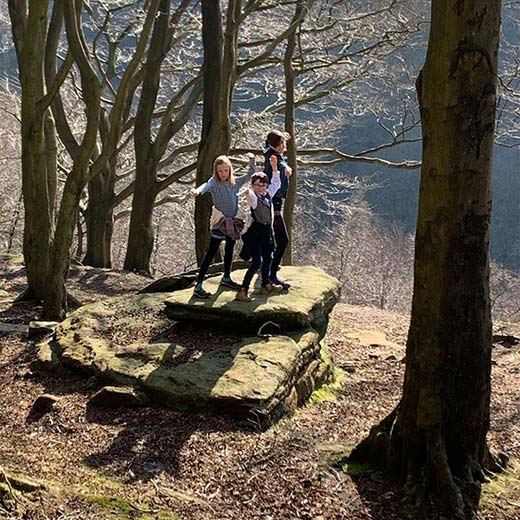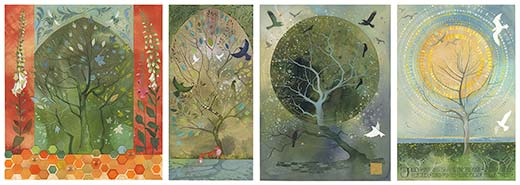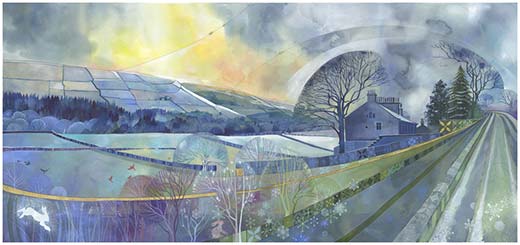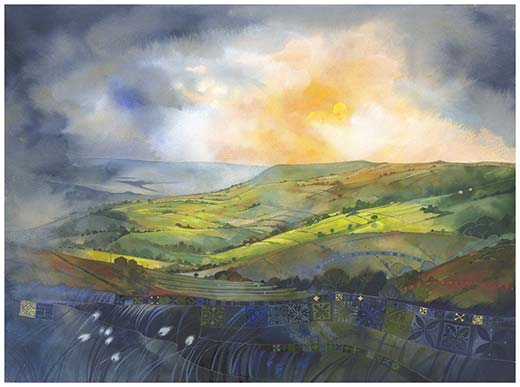
Kate Lycett
Local writer and storyteller, George Murphy interviews local characters and personalities

Introduction
Hebden Bridge artist Kate Lycett is well known for her captivating portrayals of Hebden and its surrounding towns, villages and countryside. In the latest HebWeb Interview, she describes growing up in Suffolk, her time as a fine art student, her early employment and how she rediscovered her true vocation. Kate discusses her latest project, explains the lasting influence of textile design on her style, how she is coping with lockdown and why the Pennines inspire her work. Thanks to readers for suggesting some of Kate’s questions.
Kate Lycett, Q&A
Kate, can you tell us about your latest project? What inspired it?
At the beginning of Lockdown in March last year, I started a project ‘collecting’ trees on our daily walks. Having to stay local, we were finding new paths and lovely places and it was my way of spending time with the children, but trying not to lose touch with my studio. Often I would take a photo, or do a tiny drawing, and then come back and work the drawing into something. They’re loosely based on Persian Tree of Life designs. Where each tree combines animals and birds, leaves and flowers from that walk or that place or that season. After I’d done about 8, I decided that I was going to do a full year’s worth of these lock-down trees, and then find somewhere that I could present them all together. One big wall of colourful, decorative celebration of lockdown in this valley.
New project images - click image to enlarge
I am up to about 32 trees now, and the full year is up. I am creating a book of the paintings, and writing out all the lists and little diary entries I made. My wall of trees will be shown at Bankfield Museum from September, as part of a larger exhibition of my work.
Friday morning - click image to enlarge
When did you first know you wanted to be an artist?
I’ve never wanted to be anything else. I must have been very little and I remember this magical idea of a studio, before I really knew what one was. When my little sister was a toddler, all the pens and paints were taken away after she drew all over an arm chair. So maybe the elusive studio was just a place where I would be allowed pens, and little sisters weren’t allowed.
Did you have any teachers or relatives who inspired you?
Grandad was an architect and taught me technical drawing and perspective when I was quite little. He had a studio - it was a sacred space and I felt so honoured to be allowed in it.
My Dad was always a one for looking at picture books - proper artists' books, every evening before bed. Among my favourites were Marat, murdered in his bath - a French revolutionary painting, and The Duc de Berry - Book of Hours. When I was older, he and I would often go to city art galleries and analyse the compositions of landscapes. It didn’t seem strange at the time, but looking back I realise what a lovely and formative thing it was for my Dad to do with his awkward teenage daughter.
To be honest, Art at school was very uninspiring. My Art teacher wore the same maroon overall for my whole time at high school. He once talked through an entire double lesson about the design on a carrier bag. But there was a Saturday art school which I always went to. 6 hours, uninterrupted in an art room. I learned things there, like Batik and silk screen printing, from a wonderful lady called Eve Summers. I suppose she started me off on my textile career!
I love Suffolk - Lavenham - the coast! Why did you move north?
I came here for University. I studied in York. I remember catching a train from Thetford for my interview. I had a portfolio and a man on the train asked where I was going . When I told him, he said “you’ll like it up there. They’re friendly”. He was right! And then, because I studied textiles, I stayed North because the textile industry was all in the North. I love Suffolk, but it was right to move away. It’s a place you can get stuck, I think. I go back occasionally to visit friends. I love the low horizons and the pink cottages. Suffolk is full of cool grey light - especially the coast. But after a few days, I miss the hills, and the people.
 When and where did you meet your partner?
When and where did you meet your partner?
Daniel and I have been together since we were 16. We met though Suffolk Schools Music. We were at different high schools and then different Universities, which is probably the secret to staying together as we were growing up. 28 years on and I still think he’s the nicest person I’ve ever met.
On your art course, you chose to specialise in textile design. Has that had a lasting impact on your later work?
Definitely. I did an Art Foundation year in Suffolk, which I hated. They wanted everything ‘to have an edge’ and show a teenage angst that I just didn’t feel! I just wanted to paint beautiful things. Specialising in textiles at University gave me the freedom to play with colour, texture, layering, pattern. I did lots of playing with wax pots, inks, feathers, gold, devore, Cyanotype, silk screens. I bought my first spool of gold thread in York. I was never out of the studios there. I had my own keys and would work till all hours. I loved it all!
Did you become a professional artist as soon as your course ended?
No. I went on to study for an MSc in Huddersfield, studying industrial applications for all the fun stuff I’d done on my Degree. Then I worked as a textile and clothing designer in Leeds for several years. I painted a little, on the side. The design briefs I was working to were often strict and uninspiring - especially in terms of colour, so I think I was painting all that pent-up colour frustration! I did love my job and I was always very proud to say ‘I’m a Designer’. But it wasn’t going to work around family life, so I left when I had my first daughter (she’s now 14).
Break in the clouds - click image to enlarge
Some artists go in search of sunlight. What are the challenges and rewards of painting in the Pennines?
If it was sunny all the time, it wouldn’t seem so precious. I love to find the beauty that some people don’t see. The light in Yorkshire changes all the time. Like the patch of sunlight moving across the hills - you don’t get that in Suffolk. I didn’t love the hills and the moors until I started fell running a few years ago. I found the moors oppressive and often bleak. Now I couldn’t imagine living anywhere else. Every day of lock-down I’ve felt fortunate to live where I do.
What is your method of working? How tidy is your studio?
I have days where I paint, and days where I stitch my prints. I have to have a different mind set for my different days. My studio probably looks like chaos, but I’m fastidious about order in the really important things, like how the colours and brushes are organised. But be completely unaware of the stacks of dirty mugs and the paint all over the floor.
Do you listen to music while you work?
Sometimes I just like quiet, and to listen to the birds. It’s a novelty after having the children home so much this last year! But when I do listen to music, it’s a very odd mix. Maybe Bill Lawrence or Penguin Cafe if I’m painting. Billy Joel - loud - If I’m working late on orders! I also listen to audio books. Big classics that I never have the time to read anymore. Currently I love Timothy West reading Anthony Trollope novels. Some of them are over 35 hours long!
How are you coping with lockdown? Have you missed family and friends?
I’ve not seen my folks since last August and I miss them terribly. My big sister lives in Hungary, and I’ve not seen her since Christmas 2019. My running friends have kept me going through lock down blues. I really enjoy the company of Daniel and the Children, so I’ve been very lucky really. We split the home schooling duties which was best for everyone’s sanity. It would have been a different story had we not been allowed outside as in other countries with stricter lock-downs.
Looking back at your recent work, was Toffee Town a commission? Did you enjoy depicting Halifax?
In 2016, I had an exhibition at Bankfield Museum all about local Lost Houses and it was that which first got me noticing just how beautiful the architecture is in Halifax. It wasn’t a commission. The Yorkshire Gallery in The Piece Hall asked if we could do an exhibition together and I pitched the idea of Toffee Town.
What makes you happy?
The wren that sings on my studio roof. The characters my children invent. Hattie’s drawings. Daniel playing the piano. Running with friends in utterly foul weather. Tea. To be honest, I think I’m happy most of the time.
How fast can you run?!
I have no idea! I like to run up big hills, and I like to run a long way, so long as there are beautiful things to look at.
Which artist, living or dead do you most admire?
There are too many, and I go through phases. Let’s say Eric Ravillious. He was a landscape artist, latterly a war artist and died young in the Second World War. His landscapes are beautifully quiet and understated. I’m always drawn to this period; I suppose my Grandad’s generation of artists: Edward Bawden, John Piper, Dame Laura Knight.

When lockdown is eventually lifted, what would be your dream holiday?
Dunster beach in Somerset. With my Mum, my sister, and all the cousins together. I’ve missed family more than anything.
Have you watched the Hebden Bridge programme on Interior Design Masters yet?
No! It’s just that I never watch the telly. I did catch up on some of it on iPlayer, but not all of it yet. I had noticed the beautiful re-vamp of Chapter 17 from the outside months ago, and wondered what it was all about. And I’ve seen photos of the upstairs with Julia’s wonderful mural. So I think I’ve seen the best bits.
Is there a question you wish I had asked - and how would you answer it?
Q: Why do you paint? A: Some people want to change the world. I think I want to make people appreciate the one we have. I think there’s value in that.
More HebWeb interviews from George Murphy
If you would like to send a message about this interview or suggest ideas for further interviews, please email George Murphy




